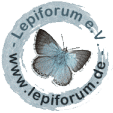

 +1Kontinente:EU
+1Kontinente:EU2. Diagnose
2.1. Falter
Corley & Ferreira (2025: 125)erklären: Megacraspedus dalei resembles M. trineae externally and in genitalia, but there are consistent differences. The forewing of M. dalei has a distinct blackish dot at end of cell. Huemer & Karsholt (2018) mention an indistinct black dot at end of cell sometimes present in M. trineae but this probably refers to M. dalei which was included under M. trineae (e.g. paratype from Braçais, Portugal)."
(Autor: Erwin Rennwald)
4. Weitere Informationen
4.1. Etymologie (Namenserklärung)
Corley & Ferreira (2025: 125) erläutern: "The species is named after Michael Dale in grateful recognition of the considerable help he has given MFVC with many excellent genitalia dissections and enhanced photos of MFVC’s own preparations."
4.2. Taxonomie
Die Art gehört in die Artengruppe um M. cuencellus und dort in die unmittelbare Verwandtschaft von M. trineae. Corley & Ferreira (2025: 125) melden zur Genetik: "Molecular data: INV09134 (IBILP3009-21) in BIN BOLD:AEI6609, (n = 1). The distance to the nearest neighbour, a probably undescribed species from Avila, is 5.77 %."
4.3. Faunistik
Corley & Ferreira (2025: 125) teilen knapp mit: "So far known only from the central part of Portugal in Alto Alentejo and Beira Litoral."
4.4. Typenmaterial
Der Holotypus der neuen Art war bisher einer der Paratypen von M. trineae. Corley & Ferreira (2025: 127) erklären: "Holotype ♂, “P5173 PORTUGAL, Braçais Castelo de Vide Alto Alentejo, 9-V-1999 leg. M. Corley” “12003’ TLMF Lep 21300 (pale green label)”. “PARATYPE Megacraspedus trineae Huemer & Karsholt, 2018” (red label). Holotype will be placed in NHMUK. Paratypes: Beira Litoral, Ceira, 1 ♂, 2006, leg. P. Pires, Corley gen. prep. 2667; Beira Litoral, Penela, Serra de Janeanes, Buracas de Casmilo, 1 ♂, 23-V-2006, leg. M. Corley, Corley gen. prep. 2758; Beira Litoral, Soure, Paúlda Madriz, 1 ♂, 26-VI-2015, leg. J. Rosete, Corley gen. prep. 5758, DNA barcoded INV09134."
(Autor: Erwin Rennwald)
4.5. Literatur
- Erstbeschreibung: Corley, M.F.V. P. & S. Ferreira (2025): The genus Megacraspedus Zeller, 1839 in Portugal with description of four new species (Lepidoptera: Gelechiidae). — SHILAP Revista de lepidopterología, 53 (209): 121-137. [zum PDF-Download auf shilap.org]



